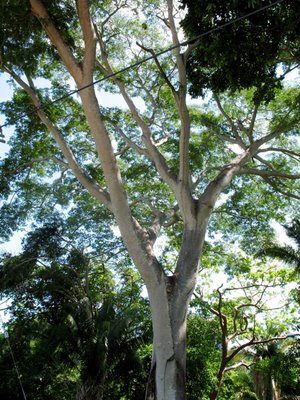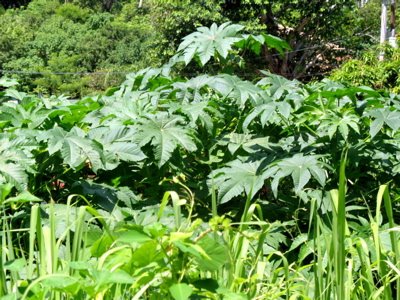 These two photos are of the Huanacaxtle tree. Also known as a Parota. This particular tree is growing in Chacala at the cattle pen, where the paved road turns toward the gated community. It has white bark and is a very big tree. It could grow to 90 feet tall and 10 feet in diameter. The Huanacaxtle is used as a hardwood, and the leaves are used in cattle feed mixtures. It's a Legume (Legumeinasae). You see it everywhere as a shade tree, for people and for cattle. And in parks in towns, and in pastures, and along side the highway, and shading homes.
These two photos are of the Huanacaxtle tree. Also known as a Parota. This particular tree is growing in Chacala at the cattle pen, where the paved road turns toward the gated community. It has white bark and is a very big tree. It could grow to 90 feet tall and 10 feet in diameter. The Huanacaxtle is used as a hardwood, and the leaves are used in cattle feed mixtures. It's a Legume (Legumeinasae). You see it everywhere as a shade tree, for people and for cattle. And in parks in towns, and in pastures, and along side the highway, and shading homes.The vultures in Chacala love to sit high in this tree, especially when the leaves are gone. Sometimes there will be more than a hundred vultures up there. First time I saw them up there I was walking by myself, and I walked really quickly to get away. They are scary looking birds.

 This is a Castor Bean plant. I don't know the other names for it, so I am having trouble looking it up. I used to be very interested in Bill Mollison's concept of Permaculture, particularly as it related to the kind of plants that move into seriously disturbed soil.
This is a Castor Bean plant. I don't know the other names for it, so I am having trouble looking it up. I used to be very interested in Bill Mollison's concept of Permaculture, particularly as it related to the kind of plants that move into seriously disturbed soil.This area, about a 1/2 acre in size, is between this house and the paved road. It was completely trashed about 5 months ago. All the dirt was removed, down about six feet or so in some areas. Other topsoil brought in to be stored temporarily, and then that soil was also removed. This area was bare abut three months ago. Now it is covered with Castor Bean plants and a few other plants I don't recognize.
It's amazing how quickly things grow here. The mile-long stretch where the new water pipe ditch came in along the paved road into Chacala was a bare strip of naked soil in June. Now you can't even tell anything had happened there. Unless, of course, you recognize that the plants along that part of the road are kind of out of place. Atypical.
I guess there's an upside and a downside to how quickly things grow here. Houses can be covered with vine in six month. At the same time, bare soil won't be washed away as easily when plants start growing within weeks of when the soil was disturbed.

2 comments:
I like your blog, but I don't know anything about gardening, so I have nothing to add!!
It is Ricinus communis and the beans are poisonous. I used to grow the redish-purplish one as a tropical accent in Texas.
Post a Comment